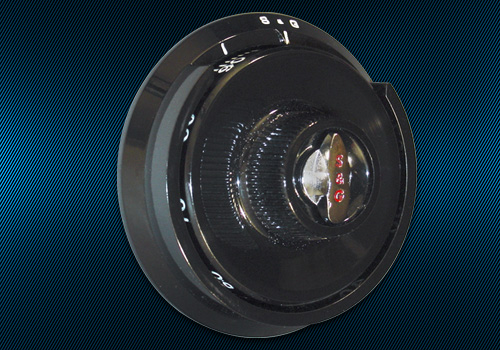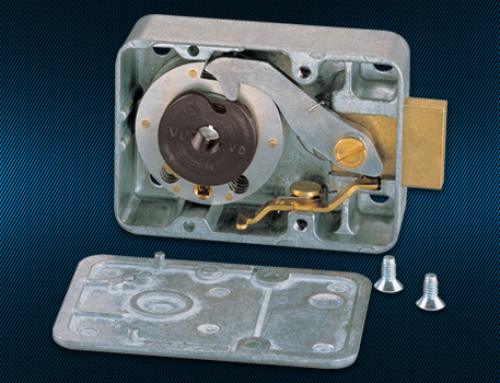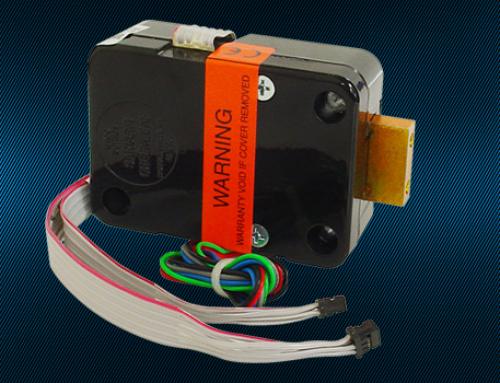Mechanical Safe Locks
In my last post I discussed five electronic safe locks in use today. In this post I will focus on mechanical safe locks. Over the years eight different types of mechanical safe locks have been used by a variety of safe manufacturers. The similarities and differences between these locks are discussed below.
1. Direct Entry
Manufactured by the Herring-Hall-Marvin Safe Company, this lock has gates in three wheels which, when aligned, accept a flat bar called a “tailpiece” which is attached to the safe’s boltwork. The driver in this lock is found at the front of the wheel-pack and the combination is changed by moving a screw.
2. Open Bottom
Manufactured by Yale, this lock has gates in three (OB) or four (OBB) wheels which, when aligned, accept the short end of an “arm” or locking “dog”. This allows the long end of the arm to pivot down; thus allowing the boltwork to move when the handle is turned to the open position. This lock has a moveable fly, a front driver, and a mesh-changing combination.
3. Drop Lever
Manufactured by Victor, this lock (L-2) has three wheels with one gate each. When these gates are aligned, the fence, which is cast as part of the lever, drops into place. This allows the lever to “push” on the lever screw, rather than “pull” on it, and thereby retract the lock bolt. The driver in this lock is found at the rear of the wheel-pack and the combination is changed by moving a pin. Sargent and Greenleaf made a drop-lever lock (6826) with four tumblers, a moveable fly, a front driver, and a mesh-changing combination. S&G also made a drop lever lock (6810) with three tumblers, a moveable fly, a rear driver, and a key-changing combination. Unlike the 6826, which made use of a lock bolt, the 6810 made use of a roller bolt. Finally, Diebold’s drop lever lock has four tumblers, a fixed fly, a rear driver, and a key-changing combination.
4. Elbow Fence
Manufactured by the Herring-Hall-Marvin Safe Company, this lock has a fence that is part of an elbow-shaped angle bar that pivots around a screw. A spring wrapped around the screw keeps the fence pressed against the wheel-pack. This lock has three wheels, a fixed fly, a front driver, and a pin-changing combination. Mosler’s elbow fence lock (B-6) comes with either three or four wheels, a movable fly, a front driver, and a mesh-changing combination.
5. Friction Fence
Manufactured by Mosler, this lock (#3) has three wheels, a fixed fly, a front geared driver, and a pin-changing combination. This lock also came with a mesh-chaning combination (#2) or a key-changing combination (KC-1). Yale’s friction fence lock (025) has four wheels, a moveable fly, a front geared driver, and a mesh-changing combination. Yale also made a friction fence lock (041) with three wheels, a moveable fly, a front geared driver, and mesh-changing combination. Finally, Yale made a friction fence lock (OC5B) with three wheels, a moveable fly, a front geared driver, and a key-changing combination. Mosler’s 5H friction fence lock was virtually identical to Yale’s 025.
6. Flipper Fence
Manufactured by Eagle, this lock (2089) has three wheels, a moveable fly, and a rear driver. This is an unusual lock because the wheels are not on a curb, yet the combination is mesh-changing. Mosler’s flipper fence lock (KCB-107) also has three wheels and a moveable fly. The driver for this lock however, is located at the front of the wheel-pack and the combination is key-changing. Mosler also made a four-wheel version of this lock that was not key-changing (B-104).
7. Spring-Assisted Drop Lever
Manufactured by Yale, this lock (0700) has three wheels, a fixed fly, a front driver, and pin-changing combination. Meilink’s spring-assisted drop lever lock (100) has three plastic wheels and a front driver; but the fly is moveable and the combination is mesh-changing. Federal’s spring-assisted drop lever lock (800) has three wheels, a front driver, a moveable fly, and a key-changing combination. The latter is an unusual safe lock because the lever pivots with the lever screw – not on it. Mosler’s spring-assisted drop lever lock (CD-120) has three wheels, a front driver, a moveable fly, and a mesh-changing combination. Mosler also made key-changing (CDK-120) and manipulation-resistant (MR-120) versions of this lock. Finally, Mosler made a spring-assisted drop lever lock with either three (CDK-302) or four (CDK-402) plastic key-changing wheels, and with either three (CD-302) or four (CD-402) hand-changing wheels.
8. Manipulation-Resistant
Manufactured by Mosler, this lock (MR-98) has three wheels, a moveable fly, a front driver, and a mesh-changing combination. This was a push-pull lock. To open the safe, one had to dial in the combination, turn the dial to zero, pull it out, and then turn it to the right to retract the lock bolt. Mosler’s MRK-120 required the same dialling procedure but was key-changing. The MR-302 was similar to the MR-98 in many respects, but had a shutter driver that “clicked” on either side of zero. Finally, Sargent and Greenleaf’s manipulation-resistant lock (M-6730-MP) had three serrated wheels, a moveable fly, a rear driver, and a key-changing combination. This was a butterfly lock. To retract the lock bolt, one had to dial in the combination, turn the dial to zero, turn the butterfly knob, and then turn the dial right to retract the lock bolt.
Mechanical safe locks come with either three or four wheels, a front or rear driver, a fixed or moveable fly, with or without manipulation-resisitant features, a square or round lock bolt, and a combination that can be changed by moving a screw, pin, mesh wheel, or by using a key-change tool. Finally, mechanical safe locks employ either a direct entry fence, a weighted arm fence, a fence that is cast as part of a lever that is gravity driven, an elbow fence, a friction fence, a flipper fence, or a fence that is cast as part of a lever that is under spring tension.









